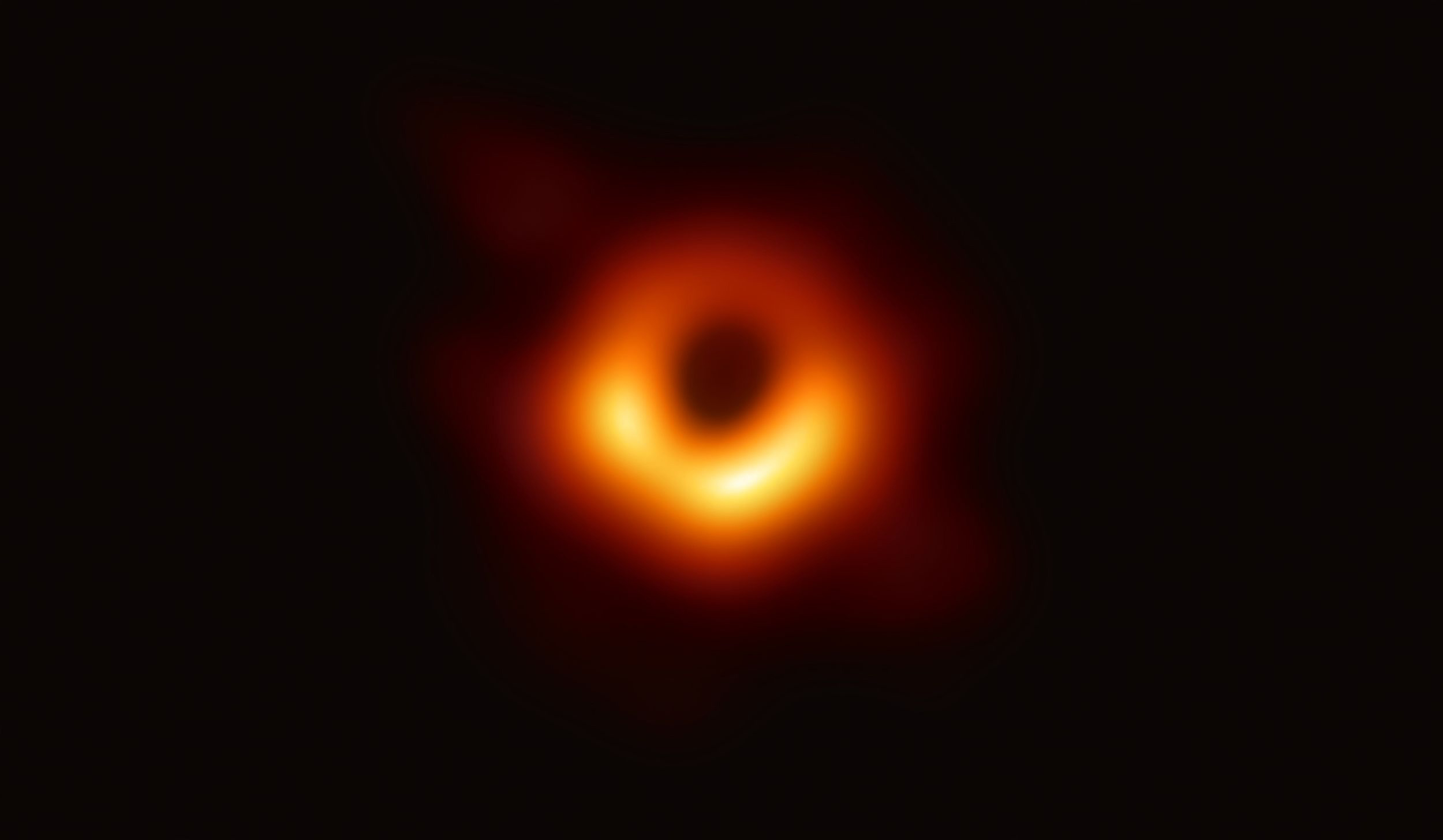關(guān)于史上第一張黑洞圖像,,你該知道這五件事

|
要拍攝吞噬光線的物體極其困難,,但科學(xué)家們終于做到了,。 事件視界望遠(yuǎn)鏡(EHT)是一個(gè)國(guó)際團(tuán)隊(duì),聯(lián)合了世界各地的八個(gè)射電天文臺(tái),,組合形成了巨大的望遠(yuǎn)鏡,,也成功捕捉到有史以來(lái)第一張黑洞的圖像。周三上午,,這張類似于《指環(huán)王》電影里索倫之眼的照片向全球公布,。 圖像中的物體位于Messier 87星系內(nèi),距離地球5500萬(wàn)光年,,這是科學(xué)家們第一次有機(jī)會(huì)觀察黑洞,,不用再靠模擬。 此事肯定會(huì)變成辦公室討論的焦點(diǎn),,所以有必要了解一些相關(guān)知識(shí),,在跟同事討論時(shí)可以隨口插上幾句,確保跟上進(jìn)度,。 什么是黑洞,?宇宙中有多少? 黑洞是恒星坍塌后密度極大的殘余物,。黑洞的引力極強(qiáng),任何物質(zhì)或光只要離得太近都無(wú)法逃脫,。 但黑洞也不像科幻電影里那樣罕見(jiàn),。科學(xué)家估計(jì),,僅在我們生活的星系里就有1億個(gè)黑洞,,不過(guò)距離地球都很遠(yuǎn),所以不必?fù)?dān)心,。 黑洞有多大,? Messier 87黑洞很大,。真的巨大。如果把太陽(yáng)放在旁邊,,只是個(gè)小斑點(diǎn)(其實(shí)永遠(yuǎn)看不到這一畫(huà)面,,因?yàn)橐μ罅耍?yáng)的光無(wú)法逃脫),。 科學(xué)家們說(shuō)該黑洞大小跟海王星軌道差不多,,而海王星繞太陽(yáng)轉(zhuǎn)一周要200年。 黑洞對(duì)附近的行星有何影響,? 黑洞內(nèi)的行星很可能會(huì)被引力壓碎,,不過(guò)實(shí)際情形只存在理論模擬。如果一顆行星繞著黑洞運(yùn)行但距離足夠遠(yuǎn),,能夠逃脫引力呢,? 你最好抓穩(wěn)什么東西再往下看。 麻省理工學(xué)院草堆天文臺(tái)的研究科學(xué)家杰弗里·克魯說(shuō),,由于黑洞巨大,,行星只用一周或更短時(shí)間便可繞行軌道一圈。不過(guò)該行星速度將達(dá)到光速,。真想體驗(yàn)的話,,最好帶上暈車藥。 拍攝黑洞的照片有多難,? 集合八家天文臺(tái)的射電望遠(yuǎn)鏡一起工作都還不夠,。因?yàn)楹诙幢扔钪嬷械娜魏紊潆妬?lái)源都要“小和黑暗”,所以各天文臺(tái)必須同步,,各種條件也得恰到好處,。 “拍到黑洞的圖像還要放大,或者相當(dāng)于從巴黎路邊咖啡館觀測(cè)紐約一部手機(jī)上文本的‘角分辨率’,?!惫俜饺耸勘硎尽?/p> 下一步怎么做,? 用科學(xué)家的話來(lái)說(shuō),,目前已經(jīng)收集到“海量”數(shù)據(jù)進(jìn)行研究。每個(gè)天文臺(tái)都接收到約100萬(wàn)GB的數(shù)據(jù),。而且從目前來(lái)看,,各家希望繼續(xù)合作。 “我們已經(jīng)證明事件視界望遠(yuǎn)鏡可以實(shí)現(xiàn)在視界面觀測(cè)黑洞,。”事件視界望遠(yuǎn)鏡圖像小組的聯(lián)合負(fù)責(zé)人秋山一矩說(shuō)?!斑@是黑洞天體物理學(xué)新時(shí)代的曙光,。”(財(cái)富中文網(wǎng)) 譯者:夏林 |
It’s pretty hard to photograph something that devours light, but scientists have finally managed to do so. The Event Horizon Telescope (EHT), an international consortium that linked eight radio observatories around the world to create an enormous telescope, has managed to capture the first-ever image of black hole. The shot, which resembled the Eye of Sauron from The Lord of the Rings films, was released globally Wednesday morning. Located inside the Messier 87, a galaxy that’s 55 million light years from Earth, the image of the cosmic phenomenon is the first chance scientists have had to observe a black hole, beyond their own simulations. It’s definitely the water cooler conversation of the day. So here are a few facts to drop on your coworkers, just in case you’re not fully up to speed on the project. What is a black hole? And how many are there in the universe? A black hole is the super-dense remnants of a collapsed star. The gravitational forces of them are so strong that nothing, neither matter nor light, can escape once it gets too close. They’re not as uncommon as science fiction films might have you believe, either. Scientists estimate there are 100 million in our galaxy alone, though none are close enough to earth to be a concern. How big is this black hole? The Messier 87 black hole is big. Really big. The sun would be a speck next to it (although you’d never know that, since the gravity pull is so strong the sun’s light couldn’t escape). Scientists say it’s about the size of Neptune’s orbit. And Neptune takes 200 years to revolve around the sun. How would it affect nearby planets? Exactly what would happen to a planet within the black hole is still theoretical, though it would likely be crushed by the gravity. But what if a planet was orbiting the black hole, yet far enough away to escape it’s pull? You’d have to hold onto something. Despite the black hole’s size, an orbiting planet would circumnavigate it in a week or less, says Geoffrey Crew, research scientist MIT’s Haystack Observatory. And that planet would be traveling at the speed of light. Bring Dramamine if you visit. How hard was it to get a picture of the black hole? This was more than getting eight facilities with radio telescopes to work together. Because a black hole is “infinitely smaller and darker” than any radio source in the sky, the observatories had to be synchronized and conditions had to be just right. “Making a picture of a black hole also requires a magnification, or ‘a(chǎn)ngular resolution,’ equivalent to reading a text on a phone in New York from a sidewalk café in Paris,” say officials. What’s next? Scientists gathered, in their own words, “gobs” of data to pore through. Each of the eight observation stations took in one petabyte of information, roughly 1 million gigabytes each. And, from the sound of things, they’re looking to keep working together. “We’ve demonstrated that the EHT is the observatory to see a black hole on an event horizon scale,” says Kazunori Akiyama, co-leader of the EHT imaging group. “This is the dawn of a new era of black hole astrophysics.” |
-
熱讀文章
-
熱門(mén)視頻











